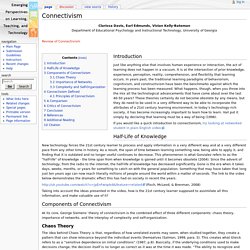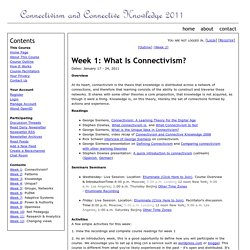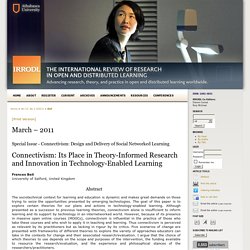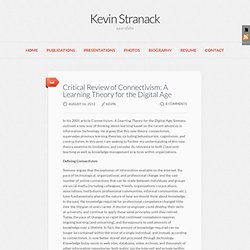

The Space Between: A recap of the incredible talks from TEDxWomen. Over the past two days, TEDxWomen brought together 50 speakers from around the globe, each giving a different slice of thinking on the state of women today.

Here, a selection of the powerful talks from this event, which was produced and curated by The Paley Center for Media. Session 1: The space between Poverty and Plenty. #moocmooc. 25 Ways Teachers Can Connect More With Their Colleagues. MOOC's. Weconnect [licensed for non-commercial use only] / PLN. Steve Hargadon - Changing Education By Hacking At the Roots, Not the Branches. Social Network Learning: Supporting Theory and Framework. Www.scriptiebank.be/sites/default/files/f74c588caa59f864b43ba82036e0743f.pdf. Connectivism. Clarissa Davis, Earl Edmunds, Vivian Kelly-Bateman Department of Educational Psychology and Instructional Technology, University of Georgia Review of Connectivism Introduction Just like anything else that involves human experience or interaction, the act of learning does not happen in a vacuum.

It is at the intersection of prior knowledge, experience, perception, reality, comprehension, and flexibility that learning occurs. In years past, the traditional learning paradigms of behaviorism, cognitivism, and constructivism have been the benchmarks against which the learning process has been measured. If you would like a quick introduction to connectionism, try looking at networked student in plain English video. Videos connectivism. Connectivism. Onderwijs-door-de-eeuwen-heen2 - Connectivisme. CocaKoll - Connectivisme. JIM-lovc14 - Connectivisme. Connectivisme is een van de leertheorieën die mij als eerste aansprak en wel om drie redenen. Ten eerste omdat het een nieuwe theorie is die zich spitst op het vermogen van leren dat verwacht wordt in het huidige tijdperk. Ten tweede omdat dit een goede aanvulling lijkt te geven op de theorieën die al bestaan binnen het onderwijs en ten derde, omdat de huidige technologie steeds meer mogelijkheden biedt binnen het onderwijs.
Graduate Program in Training and Development @ Roosevelt University. Connectivism: A new learning theory? Guest Blogger: Barry I came across the term Connectivism coined by George Siemens while doing research for TRDV 499 Master paper. The concept is interesting, giving thought to the digital era and how we learn. Week 1 - What Is Connectivism? ~ CCK11. You are not logged in. [] [] [Outline] [Week 2] Dates: January 17 - 24, 2011 Overview At its heart, connectivism is the thesis that knowledge is distributed across a network of connections, and therefore that learning consists of the ability to construct and traverse those networks.

It shares with some other theories a core proposition, that knowledge is not acquired, as though it were a thing. Connectivism. Connectivism: Its place in theory-informed research and innovation in technology-enabled learning. Special Issue - Connectivism: Design and Delivery of Social Networked Learning Frances Bell University of Salford, United Kingdom Abstract The sociotechnical context for learning and education is dynamic and makes great demands on those trying to seize the opportunities presented by emerging technologies.

Ijilth.mobilearn.es/pages/vols/vol02/ijilth1.2.002.pdf. Elearning 2.0 & connectivism. George Siemens (@gsiemens) op Twitter... Peru Educared. Itforum.coe.uga.edu/Paper105/Siemens.pdf. Connectivism: A Learning Theory for the Digital Age. Connectivism: A Learning Theory for the Digital Age December 12, 2004 George Siemens Update (April 5, 2005): I've added a website to explore this concept at www.connectivism.ca Introduction Behaviorism, cognitivism, and constructivism are the three broad learning theories most often utilized in the creation of instructional environments.

Learners as little as forty years ago would complete the required schooling and enter a career that would often last a lifetime. “One of the most persuasive factors is the shrinking half-life of knowledge. Critical Review of Connectivism: A Learning Theory for the Digital Age. In his 2005 article Connectivism: A Learning Theory for the Digital Age, Siemens outlined a new way of thinking about learning based on the recent advances in information technology.

He argues that this new theory, connectivism, supersedes previous learning theories, including behaviourism, cognitivism, and contructivism. In this post, I am seeking to further my understanding of this new theory, examine its limitations, and consider its relevance to both classroom teaching as well as knowledge management practices within organizations. Defining Connectivism In the article, Siemens outlines the fundamental principles of connectivism: For Siemens, connectivism is a significant departure from previous learning theories because it sees learning occurring outside of the individual, within the network: For connectivists, the starting point is always the individual learner (Siemens, 2005).
Applications in the Classroom Applications in Knowledge Management References. Stephen's Web ~ Stephen's Web. Online.upaep.mx/campusTest/ebooks/CONECTIVEKNOWLEDGE.pdf. Stephen downes, Researcher at National research council canada. Www.joaomattar.com/Constructivism and Connectivism in Education Technology.pdf. Groups networks and collectives - more! Scott Wilson notes some concerns with the “lack of clarity” between the three entities of the Many that Jon Dron and I have been discussing and blogging about.

An educational taxonomy or a model gains its pragmatic value by the extent to which it helps practitioners and online learning researchers develop, implement and assess learning contexts, environments and activities. This value is enhanced by clarity and lack of overlap and redundancy in the elements of the model. 15 Internet Trends That Are Changing How We Connect. 15 Internet Trends That Are Changing How We Connect by Tom Vander Ark first appeared on gettingsmart.com Mary Meeker from leading venture capital investors Kleiner Perkins presented on internet trends at Stanford last week. It’s worth reviewing. Connected Learning: 'ESSENCE'
The Half-Life of Facts: Dissecting the Predictable Patterns of How Knowledge Grows. By Maria Popova “No one learns something new and then holds it entirely independent of what they already know.

We incorporate it into the little edifice of personal knowledge that we have been creating in our minds our entire lives.” Concerns about the usefulness of knowledge and the challenges of information overload predate contemporary anxieties by decades, centuries, if not millennia. In The Half-life of Facts: Why Everything We Know Has an Expiration Date (public library) — which gave us this fantastic illustration of how the Gutenberg press embodied combinatorial creativity — Samuel Arbesman explores why, in a world in constant flux with information proliferating at overwhelming rates, understanding the underlying patterns of how facts change equips us for better handling the uncertainty around us.